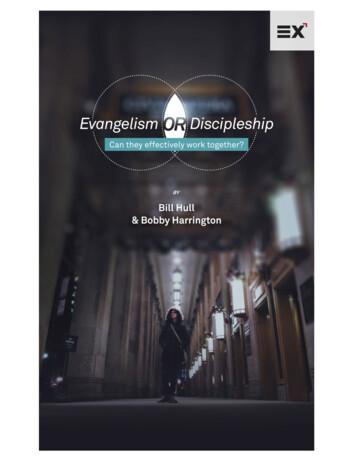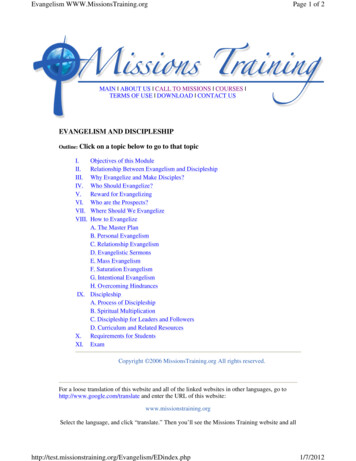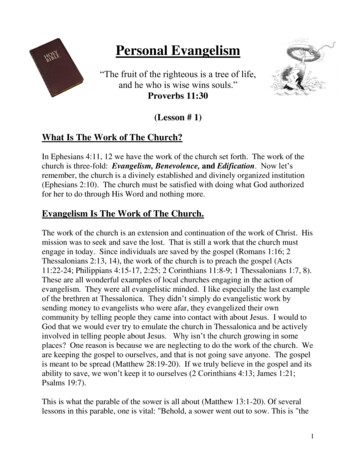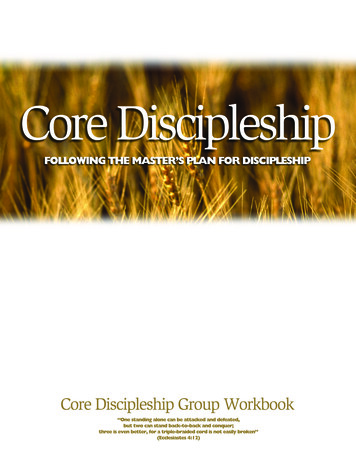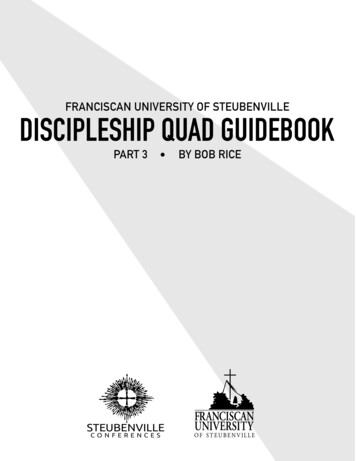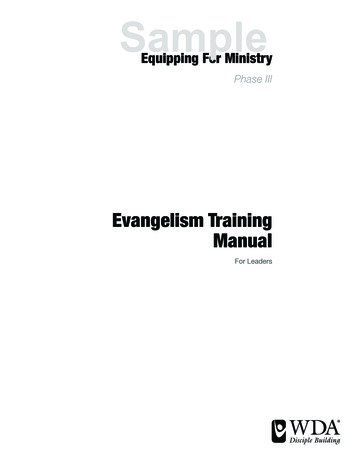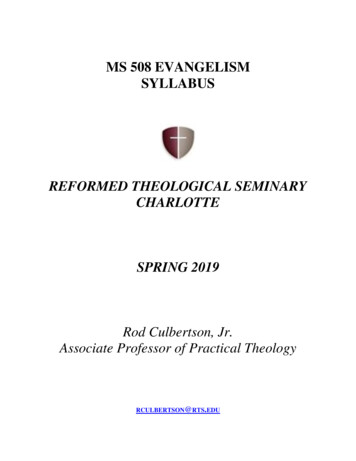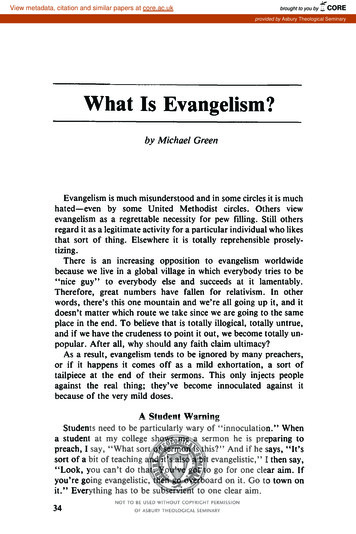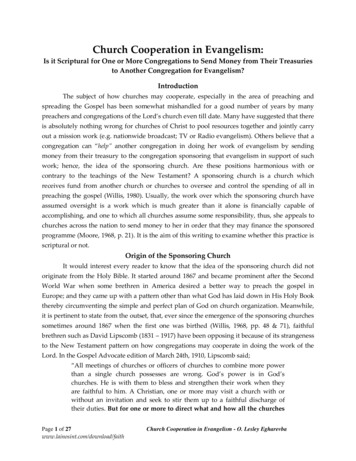
Transcription
THEDISCIPLESHIP EVANGELISMPROGRAMLEVEL 1
ACKNOWLEDGEMENTSI want to thank the Charis Bible College graduating class of 1999 for helping to produce thismaterial to make discipleship available to everyone. My deep appreciation goes to Andrew Wommackfor his vision of equipping the Saints. A special thanks goes to Dr. Loran Lewis who has helped melearn to disciple others by asking questions. I want to thank Arnold Hoffman for his continued supportand encouragement of this project. I want to thank my fellow laborers in Christ, Rocky Forry, JoeRose, Steve Klepatz, Gene Hall, Janette Light, and Danika Gravelle who have taken this material andproven it to work through a hands-on ministry in the field. I want to thank Richard and Betsy Shepherdfor their insight and counsel throughout this project. I want to thank Satoshi Yamamoto for lending hisartistic talents to our design. I want to thank my wife, Wendy, for believing in the work that we aredoing. I want to give a special, special thanks to Doris Stoll for picking up the mantle; without her helpthis project would have never been completed in a timely fashion. I want to thank all of you who are notmentioned by name, but who have contributed to this project. May your eternal rewards be great.Don Krowi
THE DISCIPLESHIP EVANGELISM PROGRAMTEACHERSANDREW WOMMACKSince founding Andrew Wommack Ministrties, Inc. in 1978, Andrew has continued to presentgreat truths from God’s Word with simplicity and clarity, through the revelation knowledge andanointing given to him from the Lord. Wherever he travels, his powerful emphasis on the Wordof God continues to set people free from sin and self-righteousness, with signs and wondersfollowing. Andrew was a pastor of three churches, and he continues to fulfill God’s calling onhis life by teaching the body of Christ the “good news” of our relationship in Jesus Christ.DON KROWDon joined Andrew in ministry in 1975. He ministered in New Mexico, Texas, and Oklahomabefore coming on staff full-time in 1988 as an Associate Minister of Andrew Wommack Ministries. In 1994 he became an instructor at Charis Bible College in Colorado Springs, Colorado.The last ten years Don has spent in weekly evangelism outreaches. The Discipleship EvangelismProgram was developed after five years of outreaches to help others in reaching out anddiscipling those turning to Christ. Don spends much time sharing with local churches and othershis concept of discipleship that has been proven to work.ii
iii
USING THE DISCIPLESHIP EVANGELISM PROGRAMThe Discipleship Evangelism Program is a 48-lesson discipleship tool that was developed out of a five-year weekly effort to reach the lost. It has been proven to work and is userfriendly. It supplies the necessary tools for anyone with the desire to disciple another person. Itcan be effectively used in cell groups, Bible studies, reaching the lost, Sunday school, newbelievers class, mid-week church services, altar call follow-up, evangelistic crusade follow-up,outreaches in the mission field, prison ministries, Bible schools, and to develop church growth aswell as to disciple your neighbors and friends.There are three levels to this program:Level 1 is designed to explain the biblical truths of Christ and Him crucified—to bring aperson into an understanding of God’s great love for them that was displayed at the cross. Level 1brings a person into repentance, the new birth, the baptism of the Holy Spirit, and water baptism.All of this is done without preaching at a person but by asking them questions to bring them to theBible for the answers. This program is designed to assist people in understanding the Bible forthemselves.Level 2 contains foundational truths of Scripture such as renewing the mind, how tomeditate on God’s Word, the importance of the local church, the authority of the believer, God’splan for marriage, God’s kind of love, and many more.Level 3 is designed to assist a person in learning to disciple others. It contains a TrainingProgram that will help a person discover the how-tos of discipling others. It may be used for atraining class in their local church and in discovering how to reach and disciple the lost. This levelis designed to bring the “disciplee” to the place of becoming a “discipler.” What has been learnedfrom a hands-on ministry of reaching others will be taught at this level.It is our desire to supply as many discipling tools as possible to assist one in reaching out anddiscipling others. In a normal local church, a congregation of 200 may only have five to ten people withteaching gifts in that entire congregation. As a result, five or ten people may reach out to disciple, butthe majority of the people become benchwarmers in our local congregations. As a result of this need,we are supplying discipleship tools for various individuals who do not necessarily have teaching gifts.On any mechanical job, to effectively get the job done, you must have a screwdriver, a crescent wrench,a voltage meter, a pair of pliers, and other tools to make sure you are able to accomplish the task. Eachpart of the discipleship program is designed to be one tool. No one tool is better than the others, so it isour goal to supply as many tools so a majority of the body of Christ can reach out, evangelize, disciple,and teach others.iv
The following is a list of the tools we provide and how each tool fits into the program:Introducing the Subject: Each subject for study is being is introduced by Andrew Wommack or Don Krow. These few pages are to be read out loud to the person or persons being discipled.A discussion may follow. Continue by asking the questions from the Teacher’s Guide or DetailedTeacher’s Guide.Outlines: Discipleship Evangelism outlines are meant to be copied on a copy machine anddistributed to each individual that you are discipling. They are to be handed out prior to playing theaccompanying lesson in the audio or video version. These outlines supply a structure of the material thateither Andrew Wommack or Don Krow is teaching. By supplying this outline, the person beingdiscipled can look at the Scriptures and the main points that these lessons are bringing out as they listento the lessons the CDs or are watching the DVD version.Teacher’s Guide: The Teacher’s Guide is a list of questions that will create a dialog betweenthe teacher and the person being discipled. They are questions that will assist people in discovering forthemselves what the Bible is really saying. These questions will create a dialog of about 45 minutesbetween the teacher and the people you are discipling. We find that the Teacher’s Guide is used mosteffectively with individuals who the scriptures declare are “apt to teach” (1 Timothy 3:2).On a few of our Teacher’s Guides we have supplied an Optional Teacher’s Guide. This willallow the person teaching to choose the course of questions to ask. For instance, we realize that thereis a great diversity of understanding concerning the subject of water baptism. By supplying the OptionalTeacher’s Guide, the person teaching is allowed to ask questions that may be more appropriate for thegiven situation. Let me restate that only a few lessons supply an Optional Teacher’s Guide.An Optional Teacher’s Guide may also be supplied by using the questions from the DetailedTeacher’s Guide in the same manner as you would use the regular Teacher’s Guide. This will give youmore options and questions to ask.Detailed Teacher’s Guide: The Detailed Teacher’s Guide was developed to help peopleteach who do not have strong teaching gifts. Instead of using only the five or ten people out of a congregation who have teaching gifts, the Detailed Teacher’s Guide allows all the members within the bodyto reach out and disciple another individual. This method has been used effectively to allow everyperson to evangelize and disciple others. It has already been proven in over 229 nations of the world.With this approach, a person is allowed to stay on track and bring out the main points of the lesson bysimply reading and asking questions. With this approach, a paragraph or section that is numbered isread out loud by the teacher or even by the person being discipled. At this point, a correspondingquestion is asked and discussed. The teacher continues to read each paragraph out loud and ask thecorresponding questions. A normal Detailed Teacher’s Guide will create a discipleship lesson of around45 minutes. The Detailed Teacher’s Guide is an effective tool in the United States as well as in othercountries where electricity is not available and DVDs, and CDs cannot be played. In these countries, aperson has more quality time to spend with the person being discipled.v
Discipleship Questions and Answer Key: Each lesson has a new set of questions with ananswer key developed by Danika Gravelle. This new section is currently being used in the peniteniarysystem of the United States. These questions allow people to study during the week to give hours ofmeditation in the Scriptures and to prepare for the weekly studies in the regular Discipleship EvangelismProgram. An Answer Key has been provided so that you may compare your answers.Additional Information: Some lessons contain more in theAdditional Information section thanothers. The Additional Information is designed to be used like a Sunday school teacher’s quarterly. Inmost Sunday schools, a regular quarterly is given to the people. A detailed teacher’s quarterly is givento the teachers to supply them with additional information and examples. The Additional Information isdesigned to give the teacher additional information and examples that pertain to the subject or lessonbeing taught. In this way, if a person being discipled asks a question that may not be in the lesson, theteacher is not thrown off by not knowing how to answer the question. Additional Information suppliesthe teacher with information that makes them very familiar with the subject being taught.Trainer Video Lessons: The Trainer Video lessons are designed to assist the person thatwants to teach the discipleship lessons. They are also tools that may be utilized by the leadership withinthe local church. As the leaders understand the principles that are contained on the Trainer Videolessons, they will be able to become trainers in their local congregations. The trainers will then be ableto give additional insight into the dos and don’ts of teaching and help train those who want to utilize thediscipleship lessons. We advise everyone to study the Trainer Video lessons to get the real heart andunderstanding of how to use this discipleship program.DVD and CD Lessons: Each lesson is designed to be played on either a CD player, or aDVD player. Each lesson contains ten to twelve minutes of concentrated teaching on various biblicalsubjects. An outline is supplied to pass out to those being discipled so they can follow along as theylisten to the presentation. After the lesson is played, questions and a dialog follow that take people tothe Bible to discover the answers. With this method of teaching, we help others discover for themselveswhat the Bible says. Our textbook is the Bible. Our prayer is that people will be helped, encouraged,and spiritually strengthened through these lessons.If you have any questions concerning this program, write to:Andrew Wommack MinistriesPO Box 3333Colorado Springs, CO 80934awmi.net719-635-1111DKM10065 Sun Ridge CircleRogers, AR 72756delessons.orgvi
vii
LEVEL 1THE DISCIPLESHIP EVANGELISM PROGRAMTABLE OF CONTENTSLESSON12345678910111213141516LEVEL 1 - TITLE OF LESSONHow to Use the Discipleship LessonsEternal LifeSalvation by GraceRighteousness by GraceRelationship with GodNature of GodRepentanceCommitmentWater BaptismIdentity in Christ 1Identity in Christ 2What Happens When a Christian SinsIntegrity of God’s WordGod’s Not GuiltyThe Power of a Spirit Filled LifeHow to Receive the Holy SpiritThe Benefits of Speaking in 214229
ix
HOW TO USE THEDISCIPLESHIP LESSONSDon KrowThere are three manuals (48 lessons) in the Disciple Evangelism program. Many people have thesematerials but don’t know how to use them. Discipleship Evangelism tools are just that—tools. Suppose Iwant to install a new water pump in my car and someone says, “I know how to put a water pump in; I’ll putit in for you.” When they ask for my wrenches to take the old one off, I say, “I don’t have any wrenches;just take it off with your fingers.” They look at me and say, “I can’t fix it if you don’t give me a tool.”Many times ministers tell people they need to go preach the gospel and make disciples. As aperson in the church, I want to say, “But how? Show me. Give me an example. Lead me.” So DiscipleshipEvangelism is a “how to” tool. It isn’t the only tool—there are others in the world today—but it is a tool.We are creating as many tools as we can, as rapidly as possible, to help people disciple the nations.Because we have new Discipleship Evangelism tools coming out on an ongoing basis, we encourage you tocheck back with us from time to time.Since you have the Discipleship Evangelism program, I would like to tell you how it works. Firstyou have a video, DVD, CD, or cassette that presents in ten minutes or less a message that introduces thesubject you are to talk about. For example, if you are going to disciple a person about repentance, youlisten to the video, DVD, CD, or cassette tape. After hearing or seeing the introduction, you turn it off andgo into your Teacher’s Guide.In the manual, there is a transcript of the presentation, so you can read the actual message. Thereason that is so important is that if you are in a third world nation where there is no electricity and can’t useDVDs, CDs, videos, or cassette tapes, you can actually disciple by reading the introduction of the materialabout repentance, eternal life, identity in Christ, or whatever lesson you are on in your Bible study group orwith the person you are discipling. There is an outline of the audio you can copy and pass out. As theteacher is talking, you can follow the audio of this presentation.Following that is a Teacher’s Guide, which is what you would use to disciple—one on one or in acell group. This guide is most effective if you have a teaching gift. It will direct you to the scriptures so youcan ask a question from them: “By the way, John, would you read Ephesians 1:22-23 aloud. Sally, wouldyou read it from the different translation you have. If someone else has a different translation, please readit from that.”Read the scripture out loud and then go to the question that is asked here. Ask the question and itwill cause an interactive Bible study to take place. They will hold up their hands and say, “Ephesians 1:2223 says such and such .” which brings about discussion so it isn’t just a one-man monologue, like asermon. This causes interaction in your group, or one on one, when you are discipling. The Teacher’sGuide gives you questions to ask, plus the answers, and takes them directly to the scriptures. Having themread the scriptures aloud causes them to discover the answers for themselves.1
The next part is a Detailed Teachers’ Guide for those who don’t have a strong teaching gift. Youcan read the material on the subject in this guide. There is a number before each paragraph or section.Then you go to the bottom of the page and ask the question. This will keep you on track so you don’t getoff the subject. You can read the paragraph, go to the bottom of the page, ask the question, read the nextparagraph, go the bottom of the page, ask the question, and you will be able to stay on the subject you aretrying to talk about and disciple.Something we have just put in our updated Discipleship Evangelism manuals are DiscipleshipQuestions in the Navigator style. This was developed after a friend of mine went into the jails and penitentiaries where the inmates have a lot of time, but don’t have the audios or videos. The questions weredesigned to allow people to study during the week, work through them, and look in the Bible for theanswers. It is a self-discipling tool that is new to our current program. A Discipleship Answer Key isprovided to check your answers.Then we have additional information for the teacher. Many Sunday Schools have quarterlies forstudents plus a teacher’s quarterly that gives additional information. The teacher needs to have moreinformation than the students, and that’s what this is. If you read the additional information by AndrewWommack or Don Krow, chances are when somebody raises their hand and says, “I thought this andthis and this,” you will know how to answer because you have studied the additional information.For a limited time we will also have a tape by Jill Reese on how to bring Discipleship Evangelisminto your local church. She has been working with local churches, training the leadership and the body ofChrist to disciple. If you are interested in bringing Discipleship Evangelism into your local church contact usat DKM, 10065 Sun Ridge Circle, Rogers, AR 72756, or our website delessons.org.We have new products available. One is Discipleship Evangelism Bible Lessons, Volume 1, thatis so simple anyone can use it. We are using it in the penitentiary system in the United States as well as thirdworld nations. Coming soon is Discipling Through Galatians, Discipling Through Romans, and Discipleship Evangelism Bible Lessons, Volume 2. You can call or write us about when these new disciplingmaterials will be available.I hope this has helped you understand how to use the product you have in your hand a little bitbetter. God bless you.Don KrowDirector, Discipleship Evangelism2
ETERNAL LIFEAndrew WommackJohn 3:16 is one of the most familiar, though often misunderstood and misapplied, passages in theBible: “For God so loved the world, that he gave his only begotten Son, that whosoever believethin him should not perish, but have everlasting life.” Traditionally, this verse has been used to teachthat Jesus came and died for our sins so we wouldn’t perish, which is where the emphasis has beenplaced; but it really says that the purpose of his coming to earth and dying for us was so that we couldhave everlasting life. It is true that our sins were a barrier between us and everlasting life, and it is truethat Jesus died for our sins so that if we believe on him we will not perish, but there is much more to itthan that. The real message of the Gospel is that God wanted to give us everlasting life.In John 17:2-3, the night before His crucifixion Jesus prayed concerning himself, “As thou hastgiven him power [authority] over all flesh, that he should give eternal life to as many as thouhast given him. And this is life eternal, that they might know thee the only true God, and JesusChrist, whom thou hast sent.” This says that everlasting life is knowing God, the only true Father, andknowing Jesus Christ whom He has sent.Many people think everlasting life is living forever, and it is true that every person does live forever;it is a misconception to think that when a person dies he ceases to exist. The spirit and the soul go backto God and the body decays in the grave, but the truth is that every person who has ever lived on earthwill continue to live in spirit form. To say that eternal life is living forever is not the whole truth; John17:2-3 makes it very clear that eternal life is not given to everyone. Some say eternal life is living foreverin heaven versus living forever in hell, but that is not what this passage is saying.John 3:36 says, “He that believeth on the Son hath everlasting life: and he that believeth[obeyeth] not the Son shall not see life; but the wrath of God abideth on him.” This says thateverlasting life can be a present tense possession, not something that will take place in the future but apresent reality. In 1 John 5:13 it says, “These things have I written unto you that believe on thename of the Son of God: that ye may know that ye have eternal life, and that ye may believe onthe name of the Son of God.” Notice that it says you have eternal life, a present tense possession.The Scriptures reveal, therefore, that eternal life is not just living forever or living forever in heavenversus living forever in hell, but it is exactly what Jesus said in John 17:3: knowing God and JesusChrist. It is more than intellectual knowledge. This word know is used throughout Scripture to describethe most intimate, personal relationship one can have, e.g. Genesis 4:1 says that Adam knew his wifeEve and, she conceived and had a son. It is referring to the sexual relationship between a man and awoman . . . intimacy. So when this says that eternal life is knowing the only true God and Jesus Christwhom He has sent, it means that eternal life is having intimacy, personal relationship, with God.Couple that with John 3:16 and this says that God loved you and me so much that He gave Hisonly begotten Son so we would not perish but have intimacy, closeness, personal relationship with GodAlmighty. That has not always been the message we have heard.3
Often you hear, “Repent or else! Turn or Burn! Either you repent, or go to hell!” There are manypeople who are drawn to the Lord because of fear, so they confess Jesus out of desperation becausethey don’t want to go to hell. If the only benefit of salvation was having our sins forgiven in order toescape hell, it would be more than we deserve. It would still be goodness on God’s part worth preaching and sharing with people, but these scriptures reveal that there is much more to salvation than justgetting your sins forgiven.If a person’s only motivation for coming to the Lord is to get his sins forgiven so he won’t perish, ifthat is what his faith is released for, he may be born again and have a ticket to heaven, but he will missout on the real purpose of salvation. The real purpose is not missing hell or even living forever in heaven,as great as that will be. The real purpose of salvation is to have intimacy, a personal relationship withGod. There are multitudes of people who have cried out to God to forgive their sins, but their goal hasnever been intimacy with God.By not explaining the real purpose of salvation, we do a disservice to the Gospel. When wepresent it as something that deals only with spiritual things, which will take place and benefit us ineternity, we are also doing a disservice to people. There are many who live in a literal present hell onearth: depressed, living in poverty, dealing with strife, rejection, hurt, and failed marriages, just trying tokeep their heads above water. When salvation is presented as dealing only with the future, many will putoff the decision to accept Jesus because they are too busy trying to survive today.The truth is that Jesus came to affect our eternal destiny so we can live forever in heaven in blessing instead of in the punishment and the curse of hell, but He also came to deliver us from this presentevil world. Jesus came to give you intimacy and personal relationship with God the Father today(Galatians 1:4).The first-century church had a concept of this that I believe our modern-day church has lost. Wecan see this in many writings, but also in history. I was in Rome when I was 18 years old and went tothe Circus Maximus and the Coliseum where Christians were thrown to the lions and burned at thestake. Other Christians then buried the dead in the walls of the catacombs to prevent the Romans fromdefacing their graves and wrote inscriptions on the walls where they buried them. One inscription whichwas translated into five or six languages, said in English, “Here lie my wife and my six-month old daughter, who gave their lives today for the glory of Jesus Christ in the Circus Maximus!” It was written likesomething the man was proud of, something for which he was glorifying God. I didn’t sense grief in whathe wrote . . . there was no despondency.These Christians had a quality of relationship with God so dynamic that there are actual accountsof Romans jumping out of the stands and running into the arena to join them, knowing they would be putto death as well. They would confess this Jesus that the Christians had died for because they saw suchjoy on their faces. Nero, the emperor of Rome, literally stuck his fingers in his ears and said, “Why mustthese Christians sing as they die?” There was such grace, such joy, that there are accounts of theChristians actually fighting over who would go first to be martyred. I say this to point out that there wasa quality of relationship with God, which was the true intent of Christianity that sometimes we misstoday.4
Jesus didn’t come only to forgive you of your sins, as wonderful as that would be. Sin is thebarrier that stands between you and intimacy with God, and Jesus came to bring you into close personalrelationship with Him. Jesus loves you and wants to know you personally. He wants to give you aquality of life that is greater than anything you could obtain from any other source. Jesus said it this wayin John 10:10, “The thief [speaking of Satan] cometh not, but for to steal, and to kill, and todestroy: I am come that they might have life, and that they might have it more abundantly.” Godwants to give you eternal life. He wants to give you abundant life.I believe that you need and want that. God died not only to forgive your sins, but to bring you intoclose, personal relationship with Himself. If you don’t know the Lord, you need to know Him for thatpurpose. If you have already been born again, you need to go beyond just getting your sins forgiven andenter into everlasting life with the Father. God bless you as you consider that today.5
ETERNAL LIFE(Outline)1.The Purpose for the Gospel is Eternal Life.A. Jesus came to give eternal life. John 3:16: “For God so loved the world, that he gave hisonly begotten Son, that whosoever believeth in him should not perish, but haveeverlasting life.”B. Sins were a barrier.2.Everlasting life is knowing God. John 17:3: “And this is life eternal, that they mightknow thee the only true God, and Jesus Christ, whom thou hast sent.”A. Everlasting life is not just missing hell.B. Everlasting life is not just going to heaven.3.Knowing God is an intimate relationship.This intimacy is similar to that found in the marriage relationship: Genesis 4:1 says “And Adamknew Eve his wife; and she conceived, and bare Cain, and said, I have gotten a man fromthe LORD.”4.Eternal life is available now. 1 John 5:13: “These things have I written unto you thatbelieve on the name of the Son of God; that ye may know that ye have eternal life, andthat ye may believe on the name of the Son of God.”Galatians 1:4: “Who gave himself for our sins, that he might deliver us from this presentevil world, according to the will of God and our Father:”John 3:36: “He that believeth on the Son hath everlasting life: and he that believeth notthe Son shall not see life; but the wrath of God abideth on him.”Quality relationship with mankind is God’s goal.6
ETERNAL LIFE(Teacher’s Guide)1.According to John 3:16-17, what was the purpose of God sending Jesus into the world?To save the world, giving all who believe everlasting life by removing sin’s penalty.2.Explain “know” in the biblical usage of Genesis 4:1.“Know” means to have an intimate relationship with a person—the sexual union inmarriage.According to John 17:3, what is eternal (everlasting) life?Eternal life is knowing God and Jesus Christ.3.According to 1 John 5:11-13, when does eternal or everlasting life begin?At the time of belief . . . NOW!4.According to John 10:10, what kind of life did Jesus come to give us?Abundant life! Explain in your own words the quality or attributes of an abundantlife.The theif comes to kill, steal, and destroy. What does Jesus do that is the opposite of this?He gives us life for death, and restores what has been destroyed.Many think salvation is just the forgiveness of sins. The word “saved” in the Greek is “sozo”and means “to save, heal, cure, preserve, keep safe and sound, rescue from danger or destruction, deliver. Sozo saves from physical death by healing, and from spiritual death by forgiving sinand its effects. Sozo in primitive cultures is translated simply, ‘to give new life’ and ‘to cause tohave a new heart’” (SFLB p. 1525). This is abundant life!5.Do you believe that God sent His Son Jesus into the world to die for the sins of the world,thereby giving us who believe eternal/everlasting life?Yes.6.Is it clear to you that eternal/everlasting life is not only a length of time (eternity) but a quality andquantity of life?Yes.7
ETERNAL LIFE(Detailed Teacher’s Guide)Note: The following information may be read out loud (a numbered section at a time) with theperson(s) being discipled. After each numbered section is read, pause and ask the question(s)that correspond to the paragraph(s) and then discuss them.The Bible states in John 3:16: “For God so loved the world that he gave his only begottenSon, that whosoever believeth in him should not perish but have everlasting life.”Most people focus on the part of this verse that promises we won’t perish. Although it’s certainly a wonderful promise, it is not the focus of this verse. The primary purpose of Jesus coming to thisearth was not forgiveness of sins but to give us eternal life.12Sin separated us from God so Jesus dealt with sin. However, His payment for sin was just astep toward His ultimate purpose of reconciling man to God. If someone believes that Jesus died for hissins but doesn’t go on to enter into the close fellowship with God that Jesus made available, then he ismissing eternal life.Eternal life is not a length of life but rather a quality of life. Eternal life is intimacy with the Fatherand Jesus (John 17:3). Many people have been done a disservice in being told that Jesus came toforgive their sins, period.
The Discipleship Evangelism Program is a 48-lesson discipleship tool that was devel-oped out of a five-year weekly effort to reach the lost. It has been proven to work and is user- . It contains a Training
